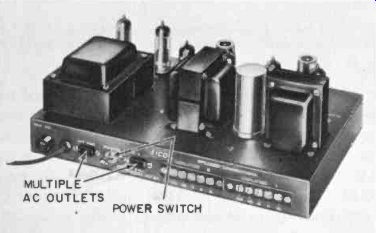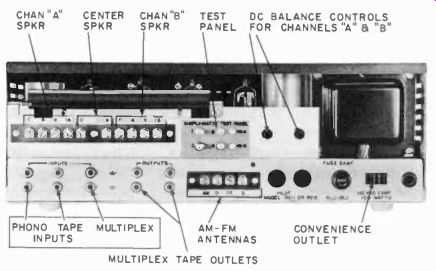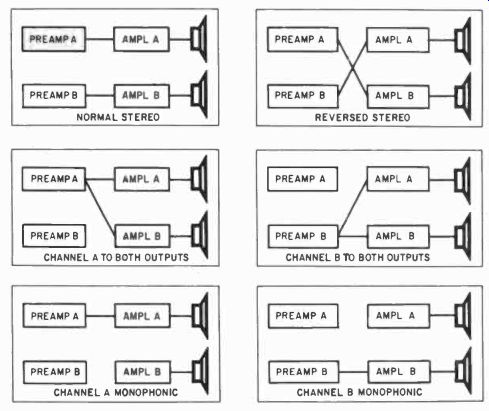WHILE most connections required between the various units of a hi-fi system are simple and self-evident, a little care expended in making them properly will avoid a host of troubles later. Probably the best place to start is with connections to the power source, which brings up the matter of the primary power available. The bulk of installations in the US are supplied with 60 cycle, 115-volt ac, with one side of this line firmly grounded to the household water line at or near the electric service entrance.
Primary power sources
However, 50-cycle ac is supplied in a few parts of the country, and a few buildings in some cities are supplied with 25-cycle ac.
Most 60-cycle equipment will operate on 50-cycle ac, but, of course, synchronous motors will run slower by one-sixth their nominal speed. Most manufacturers can supply the required size of motor pulley to make the turntable run at the proper record speed, and will do so without charge, if requested. In Los Angeles, for example, for years certain areas of the city had 60-cycle current, while adjacent areas had a 50-cycle supply. A stock of both sizes of motor pulley solved that problem.
Unfortunately, 60-cycle equipment usually will not operate satisfactorily on 25-cycle current. There is seldom enough primary inductance in the power transformer, for one thing, and it will merrily overheat and go West in a cloud of smoke not long after you plug it in, if it doesn't blow a fuse somewhere. Yes, it's possible to buy a rotary converter that will run on 25-cycle power and deliver 60-cycles for the equipment, but such units are both expensive and hard to find. Luckily, you're not likely to get many clients who have 25-cycle supply to contend with any more.
But 120-volt dc is quite another thing. A few areas in relatively large cities like New York still have this current supply, a relic of the days when there was competition between utilities for the same service area. Suitable converters for running ac equipment from such a supply are standard catalog items, and constitute the only practical solution when the client does not wish to convert his entire house or apartment to ac. Such a changeover in current supply is feasible in many dc areas now, but a client may balk at the expense involved in also changing over every last refrigerator, vacuum cleaner, food mixer, and other dc motors he may have acquired over the years.
Dc power sources In house trailers and yachts, the primary electric supply when not hooked up to the utility line in some more or less permanent location may be 6.3-, 12.6-, 25.2- (nominally called 24) or 32-volt direct current supplied by storage batteries, or by a gasoline-driven generator across which the batteries are floated. For any of these supplies, dc-to-ac conversion units can be obtained, as in the case of 120-volt dc utility power. The 32-volt system is particularly common on isolated farms generally located too far from utility lines for service.
With all unusual current supplies, the important thing is to find out what it is, and which pole, if either, is grounded. Don't forget about it when you are making the installation, either; you can burn out a good ac soldering gun readily on a 120-volt dc supply. This applies to signal generators and other contraptions having power transformers, too, and even to soldering irons having thermostatic heat controls. If you are unfamiliar with such jobs, the trusty, self-contained multimeter and extreme caution are your best allies.
Another easy-to-use tester is the neon type mounted on a pair of test leads. There are two tiny rods inside the bulb. If the line voltage is ac you will note a glow around both rods. If the line voltage is dc, the glow will appear around just one of the rods. It only takes a second to make the test, and at the same time get the assurance that power is being delivered to the outlet.
In connection with dc supplies and converters, a final word is necessary. Not all converters are suited to use where the output frequency, and to an extent the waveform, are fairly critical, as is the case with a hi-fi system. Be sure the converter ordered is of a type meant for the kind of service you have in mind, or you may have a very unhappy client on your hands.
Power connections

Fig. 501. Convenience ac outlets are usually provided on power amplifiers.
This model has one switch-controlled outlet and one receptacle that
is always turned on. (Electronic Instrument Co.)
While a lot of equipment can just be plugged into the wall socket and snapped on, a little thought in a hi-fi setup will often result in greater operating convenience. Arranging the line connections so that a single switch applies current to the main amplifier, preamp and turntable motor, is an example (Fig. 501). The nature of the system and the client's wishes will govern, but the final setup should take into account the noise, interference and safety factors discussed in Section 7.
If the hi-fi setup includes quite a number of units, so that the total power drain is a few hundred watts, it is well to check the fusing of the branch line from which it will be supplied, as well as the other loads that may be connected. A TV set and a toaster may be all it takes to insure a succession of blown fuses.
Interconnection problems
In a straightforward hi-fi setup that includes only units that have transformer-type power supplies, the interconnections of tuner, preamplifier, power amplifier, phono and tape inputs, AM-FM antennas, speakers and so on are usually only a matter of having cables with the right connectors for the application (Fig. 502).
Now and then, however, the question will arise of applying the output of a so-called ac-dc device to an input of a hi-fi system.

Fig. 502. A stereo pre-amp-amplifier combination has many input and
output terminals for greater versatility. (Pilot Radio Corp.)
These units should actually be described as "transformerless-electronic items, since they were originally developed in an effort to cut the manufacturing cost of table-model radio receivers by eliminating the relatively expensive iron-cored transformer and choke of the older form of power supply. Indeed, a good many ac-dc sets won't play satisfactorily on the 120-volt dc utility supply still found in some parts of New York and a few other cities.
The usual difficulty in interconnecting such units with regular ac units is to avoid connecting the hot chassis of the ac-dc unit to the chassis of the preamplifier. At best, this is makeshift and potentially unsafe because of shock hazard, unless certain measures are taken. At worst, it can also bring in severe hum and noise problems, and the result very seldom justifies the effort required to achieve it.
The reasons for this state of affairs are not hard to find. For one thing, the quality of reproduction provided by all but a very few ac-dc receivers leaves much to be desired. Since the unit is an economy item, designed and manufactured to meet a price, it is inevitable that some quality sacrifices have been made in the design. Since the maker wants to get by with a minimum amount of power supply filtering, the low-frequency response is deliberately sacrificed so that the hum and ripple won't be too audible.
And to get the maximum possible gain from the usual five tubes, all grid and load resistors of the usual two audio stages are of the maximum permissible value. This insures that the high-frequency response will also droop rapidly above the mid-range. Yes. It is possible to modify such a receiver to provide much better performance, but the effort and expense are seldom, if ever, justified.
Low-fi and hi-fi
If your client insists on piping the output of some five-tube midget radio into the system in lieu of a good AM tuner, the wisest course is probably to replace the output transformer in the ac-dc receiver with a fairly good one that has a 500-ohm winding in addition to and completely separate from the voice-coil winding. Run a coaxial line from the 500-ohm winding to a suitable input of the preamplifier, and hope for the best. Some times, only the use of a transformer with a balanced 500-ohm winding, with the center-tap grounded, will get rid of persistent hum and ripple troubles.
Overloading
Don't forget the possibility of overloading the input circuit of a preamplifier or power amplifier with the output from a tuner or TV receiver sound channel. Section 7 discusses methods of coping with such a situation. Most tuners made for hi-fi installations have a potentiometer in the output circuit, perhaps located on the rear chassis apron as a screwdriver-operated control. This is usually the most convenient way of adjusting the level of several input sources to provide substantially uniform level when switching the preamplifier from one input source to another.
Usually, it will be best to adjust the master volume control of the hi-fi system to a setting that provides the maximum loudness that will be required from the system, taking the output of the pickup as the signal source. Without changing the master setting, switch the preamplifier to each of the other signal input channels in turn, and set the level to about the same value by adjusting the output control of the signal-source device, such as the FM tuner.
By this means, the risk of overdriving the preamplifier is avoided, and switching from input to input will not require frantic grabs at the master volume control.
If your installation problem is that of converting from mono to stereo, consider the use of a remote-control unit .
For a completely new installation, however, the flexibility of mono and stereo operation can be controlled directly at the preamplifier. In one commercial unit switching facilities are combined on one simplified, convenient control to enable the listener to select instantly any desired mode of operation. The preamplifier has a special selector switch, choosing stereo normal. stereo reverse, either channel separately or either channel mono phonically through both outputs (see Fig. 503).
Cable and wire considerations
Most interconnections between units of a hi-fi system must be made with coaxial shielded wire of the type called microphone cable or cord. This is required because signals are still at a relatively low level (up to a volt or so) until they reach the input of the power amplifier. Cords fitted with many combinations of connectors for such use are now commercially available already made up, and can be a great time and labor saver in an elaborate system. When a line must be made for a specific use, use extra care in cutting and stripping, for a single strand across the signal path can cause an exasperating scratching noise and be very hard to locate.

Fig. 503. For new stereo installations where no conversion is involved,
the pre-amplifier is usually provided with switching facilities for
selecting a wide variety of operational modes. (Allied Radio Corp.)
Speaker wiring
As to speaker wiring, consider two requirements sometimes overlooked. If the line is longer than 10 or 15 feet, use No. 16 wire (at least) and preferably No. 14, if the speakers are supplied directly at voice-coil impedance. The makers of hi-fi amplifiers go to great trouble to provide a good damping factor in the amplifier, and this can be considerably reduced by excessive resistance between the amplifier output and the voice coil. In some cases, it may also be necessary to run the speaker line in an outer shield braid to prevent feedback or crosstalk into telephone or intercom lines. This is more likely in installations in public rooms like a hotel lounge, but should not be forgotten in a residence installation if several lines must run near each other.
Multiplex adapters
In most stereo systems, chances are that FM radio multiplex will be added at some future date, so you might as well make some provision for a multiplex adapter. The adapter will be about the size of a medium-size power amplifier, and you can ...

Fig. 504. FM-AM tuner usually has three outputs. The FM and AM outputs
are usable as is. FM and multiplex outputs are connected to the multiplex
adapter if one is used.
... allow some space for it at the rear of the cabinet. The only controls on the unit are of the semi-permanent type. Set them once and you won't have to change them again until the missus decides to move some furniture around.
When installing the multiplex adapter, there will be four cables to connect: two from the tuner (the straight FM output and the output labeled "multiplex" in Fig. 504) to the adapter, and two from the adapter to the inputs of the stereo amplifier.
The adapter is fully compatible so you won't have to make any changes in the wiring for monophonic listening as long as the stereo preamp has suitable switching functions.
Stereo realism
When you adjust the channel separation control, use your customer as the "guinea pig", having him tell you when the separation and stereo effect suit him (or his wife) the best. This method helps avoid future callbacks and complaints about the "realism" of the stereo effect. This is a case where you cannot depend on your own ears to guide you, especially since you'll be crouched behind or alongside the cabinet making the adjustments, instead of in the optimum listening area.